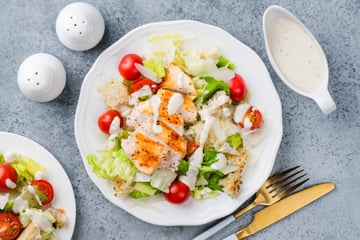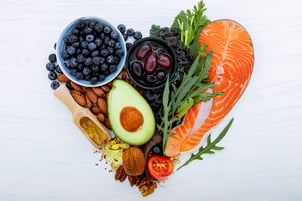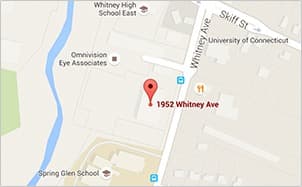Setting the Table for Eating Well with High Blood Pressure

Over 65 million Americans have high blood pressure. One way to lower blood pressure is to eat foods low in sodium. You may have heard about the DASH diet. DASH stands for Dietary Approaches to Stop Hypertension. It showed that you can lower blood pressure a lot with changes to your diet. Salt certainly plays a role; in fact, the greatest reductions in blood pressure were seen with intakes of sodium at 1,500 mg per day. But there is far more to a blood pressure-friendly diet than minimizing salt intake. Fruits, vegetables, lean proteins, beans, whole-grain carbohydrates, low fat dairy foods also have healthful effects on blood pressure.
Eat More Real Food
Do you remember the five food groups? Fruits, vegetables, whole grains, protein foods and dairy are the basis for a healthy diet. These foods in their natural state are usually very low in sodium and should be included on every plate. They also provide your body with essential minerals like potassium, magnesium, and calcium, that work with your body to naturally manage your blood pressure.
Fruits are sweet, colorful and fun to eat and make great portable snacks. Frozen and canned varieties are budget friendly and can be included in your diet; just be sure to look for “no sugar added” or varieties packed in 100% juice. Aim for 2-3 servings of fruits per day, about ½ cup each.
 The most consumed vegetable in the United States is the potato. In its natural form, the potato is a low calorie, delicious, potassium rich choice. It is how we prepare the potato by frying it, adding butter, sour cream, and salt, that takes it from superfood to super unhealthy. Beyond french fries, there are many more vegetables to enjoy and frozen or canned varieties can be part of your blood pressure lowering plan. Ensure canned vegetables are heart healthy by choosing “no sodium or no salt added,” or “low sodium” options. Try roasting chopped vegetables like zucchini, onion, mushrooms, cauliflower, carrots and more with salt free seasonings in the oven. You can include 1-2 cups of nonstarchy vegetables like these with every meal. Steer clear of pickled vegetables or vegetable juices. These items are extremely high in sodium and their perceived benefits are “not worth their salt.”
The most consumed vegetable in the United States is the potato. In its natural form, the potato is a low calorie, delicious, potassium rich choice. It is how we prepare the potato by frying it, adding butter, sour cream, and salt, that takes it from superfood to super unhealthy. Beyond french fries, there are many more vegetables to enjoy and frozen or canned varieties can be part of your blood pressure lowering plan. Ensure canned vegetables are heart healthy by choosing “no sodium or no salt added,” or “low sodium” options. Try roasting chopped vegetables like zucchini, onion, mushrooms, cauliflower, carrots and more with salt free seasonings in the oven. You can include 1-2 cups of nonstarchy vegetables like these with every meal. Steer clear of pickled vegetables or vegetable juices. These items are extremely high in sodium and their perceived benefits are “not worth their salt.”
Whole grains like brown rice, bulgur wheat, oats and quinoa are naturally low in sodium and are rich sources of fiber, also needed for a healthy heart. Include these foods in 1/3 cup portions with meals. Try seasoning rice or grains with fresh garlic, lemon, chopped onion, or fresh herbs instead of adding salt. Instant flavored noodles and rice can contain more than the recommended sodium needs for an entire day, so use these items sparingly. These refined carbohydrates can also contain added sugars and fats which do not support a healthy weight or blood pressure. They should be eaten in moderation.
Fresh protein foods like poultry, fish, lean beef, beans and eggs are low sodium foods that provide muscle building proteins that help us feel full and provide the body with magnesium. Three ounces, roughly the size of a deck of playing cards, is recommended for meals. Cured meats such as bacon, sausage, hot dogs and deli meats can be very high in sodium and should be limited when attempting to lower your blood pressure. Canned beans can be added to rice and home-made soups or chili, just be sure to rinse them under water before adding to your favorite low sodium recipe.
Two servings of low-fat dairy foods like milk and yogurt are an excellent source of calcium, a mineral that is essential for heart function and contain moderate sodium. Consider using ½ cup of yogurt to fruit smoothies or drinking 1 cup of milk with a meals or snacks. Be sure to read the label on processed cheese foods like American cheese, or cottage cheese cups. There is a great deal of added salt in these foods added in their manufacturing and production.
Making the DASH
Like any new habit, eating better and including foods with less sodium in your diet can take time. Don’t expect perfection at first and allow your taste buds time to adjust. Just by adding more foods in their original form and cooking more at home (without adding salt), you can drastically reduce how much sodium you eat while improving your health. Foods lower in sodium might taste differently at first, but in time, you will enjoy them and adapt to new flavors. Meal planning can help you to include foods that support your blood pressure and can be a fun new way to consider your eating.
Clinical Trials
Here at Chase Medical Research we are now conducting a trial for individuals with uncontrolled blood pressure. If you are interested in participating in an uncontrolled blood pressure trial or any one of our other trials, don't hesitate to check out our home page for currently enrolling trials.
References:
- United States Department of Health and Human Services. National Institute of Health. National Heart Lung and Blood Institute. Your guide to lowering your blood pressure with DASH. Accessed at: https://www.nhlbi.nih.gov/files/docs/public/heart/new_dash.pdf. 10 April 2021.
Share This Post
Recent Posts
- The Relationship Between Obesity and Obstructive Sleep Apnea April 22 2021
- Cardiovascular Outcome Clinical Trials April 22 2021
- Diabetic Peripheral Neuropathic Pain April 22 2021
- Are All Types of Cholesterol Bad? April 22 2021
- Blood Pressure: The Highs, the Lows, and Everything in Between April 22 2021
Categories
- Clinical Trials
- Cardiovascular Disease
- Diabetes
- Obesity
- Kidney Disease
- Hypertension
- Pain Management
- Vaccine
- Cholesterol
- Chronic Obstructive Pulmonary Disease
- Diabetic Peripheral Neuropathy
- Migraine
- Osteoarthritis
- Biologics
- COVID-19
- Gastroesophageal Reflux Disease
- Irritable Bowel Syndrome with Constipation
- Lyme Disease
- Nonalcoholic Steatohepatitis
- Respiratory Syncytial Virus


